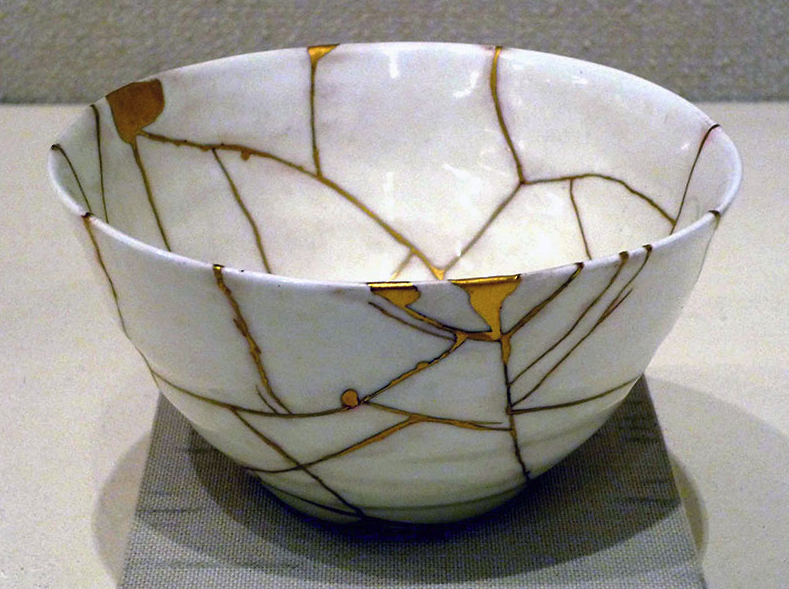Imperfection is beauty, madness is genius and it’s better to be absolutely ridiculous than absolutely boring.
~ Marilyn Monroe ~

Growing up in Hawaii, I had the opportunity to be immersed in many different cultures. A predominant one was the Asian way of life, Japanese in particular.
Over the years, I would find myself staring at various decorative objects at friends and family homes; gorgeous colorful scrolls, exquisite bonsai arrangements, and tranquil sand/rock gardens. However, I was always struck by beautiful pottery pieces which usually had some lines of gold or silver randomly placed within its structure.
Little did I know I was actually looking at the Japanese art of Kintsugi.
It’s only been recently I have discovered the deeper meaning of those exquisitely beautiful pottery pieces.
Legend has it this art form was created during the 15th century when a Japanese shogun sent a cracked tea bowl to get repaired and was highly displeased when it came back mended with metal staples. This motivated the craftsmen of the time to find an alternative and aesthetically pleasing method of repair. Kintsugi was born.
Kintsugi: golden (“kin”) and repair (“tsugi”)
The traditional technique uses a precious metal (either liquid gold, liquid silver or lacquer dusted with powdered gold) to mend broken pottery and simultaneously enhance the breaks. As the fragments are joined it gives them a new more refined appearance with an added benefit of strengthening the piece. Each repaired item is unique and rare due to the randomness of the shattered pieces and irregular patterns of the metal additions.
By making these restorations, the pottery gets a new lease of life. It also teaches us broken items are not something to hide — display them with pride.
Life Imitates Art
Kintsugi is a metaphor for brokenness and healing … embracing one’s scars and imperfections can create something strong, unique, and beautiful. It can inspire and encourage us in our everyday lives:
- Embrace and accept asymmetry: when pottery breaks, it rarely, if ever, breaks evenly. In turn, life is messy and unpredictable. It’s full of devastation, betrayals, and losses, as well as new beginnings, devotion, and wins. In Kintsugi, the cracks are in plain view, not hidden, used as part of the design. It’s a reminder — scars are a souvenir of the “bad” and will always exist, yet they have the powerful effect to create something beautiful.
- Readjust: Zen philosophy encourages us to embrace our failures and setbacks; identifying ways to turn them into our advantage. This is exactly what the craftsmen uncovered when founding Kintsugi … they filled the cracks with powdered precious metals and elevated them into works of art. This method’s power lies in the absolute refusal to hide or disguise the object’s brokenness. The aim wasn’t to make the item good as new, but transform it into something different, stronger and more valuable.
- Embody resilience: Being “broke” isn’t the end of the world; moving forward is an option. Kintsugi encourages this by inscribing the vase’s story into its structure. We see the moment of breakage, the fact it was loved or valued enough to be repaired, and then likely handled with tender care in the future. (More information on ‘Resilience’, a guidepost for wholehearted living, can be found here.)
The lessons learned from Kintsugi are numerous — shifting from what is lost to what is gained. From broken to transformed. From less to more. It offers us a way to look at honoring the experiences of our lives and realize all the cuts and bruises add depth, significant worth, and value to our being.
Kintsugi reminds us nobody is perfect. The path is not straight. And the deepest wounds, hardest challenges and greatest fears are the most precious, admirable and beautiful parts of people.
If you are interested in one way to put our lives back together, I will be hosting a Create Your Life Online Vision Board Workshop … please click here for more details.
